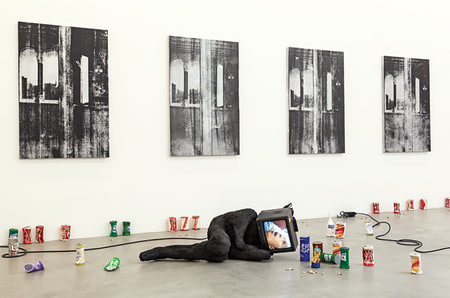
In 2003, a group of Cooper Union alumni formed an organization to maintain and promote the artistic legacy of “Bruce High Quality,” a fictional artist who died in the 9/11 attacks. Since then, the Foundation has brought the gospel of Bruce to the Whitney Biennial as well as to shows at Brown University in Providence, Rhode Island, and the Brooklyn Museum, to name a few. For their exhibition in Brussels, the collective produced an impressive installation that referenced two of Belgium’s best-known artists.
“Vive la Sociale!” was based on—among other things—James Ensor’s famous painting Christ’s Entry into Brussels in 1889, 1888, now in the collection of the J. Paul Getty Museum in California. In this work, we see a Christ who resembles the painter himself surrounded by an indifferent crowd of people, most of them masked. Across the top of the painting, we see a banner with the slogan VIVE LA SOCIALE, referring to the rise of socialism in that era. In BHQF’s interpretation, we saw, in front of a reproduction of Ensor’s painting, twelve dark figures made of asphalt and other materials, evoking the twelve apostles. Their heads are television sets showing a variety of disasters, banal rituals, and, on one screen, even a karaoke program that invites you to sing corny songs such as “Have I Told You Lately That I Love You?” The sound coming from the other TVs doesn’t at all match their images of shootings, shipwrecks, and so on, but consists of platitudes such as “I love what you’ve done with the place,” “Every day is a gift,” and “Adorable!” In between the twelve figures and covering the whole surface of the space were cigarette butts, empty beer cans, and other party litter. But there was something odd about this trash. On second glance, it turned out that many of the objects were slightly oversize and made of Play-Doh—sculptures of refuse that were, in fact, pure craftsmanship.
Completing this impressive installation, twenty replicas of another, even more iconic masterpiece hung on the gallery walls. The exterior middle panel of Jan van Eyck’s Ghent Altarpiece includes a view through a window: We glimpse what the city of Ghent looked like in the fifteenth century. In isolating this window view, silk-screening it as a series in different shades of gray, and hanging it on both walls next to their own version of Ensor’s painting, BHQF made what would have otherwise evoked nothing more than a gallery after an opening when it’s ready for the cleaning crew feel instead like some kind of eerie contemporary chapel. The only witnesses to what had happened earlier were the twelve dark apostles. Was it a coincidence that one of the karaoke tracks was the Joan Osborne hit “One of Us”: (What if God was one of us?) Ensor might well have nodded in approval at BHQF’s brilliant contemporary “translation” of his apocalyptic nineteenth-century vision of a society on the verge of a total collapse.